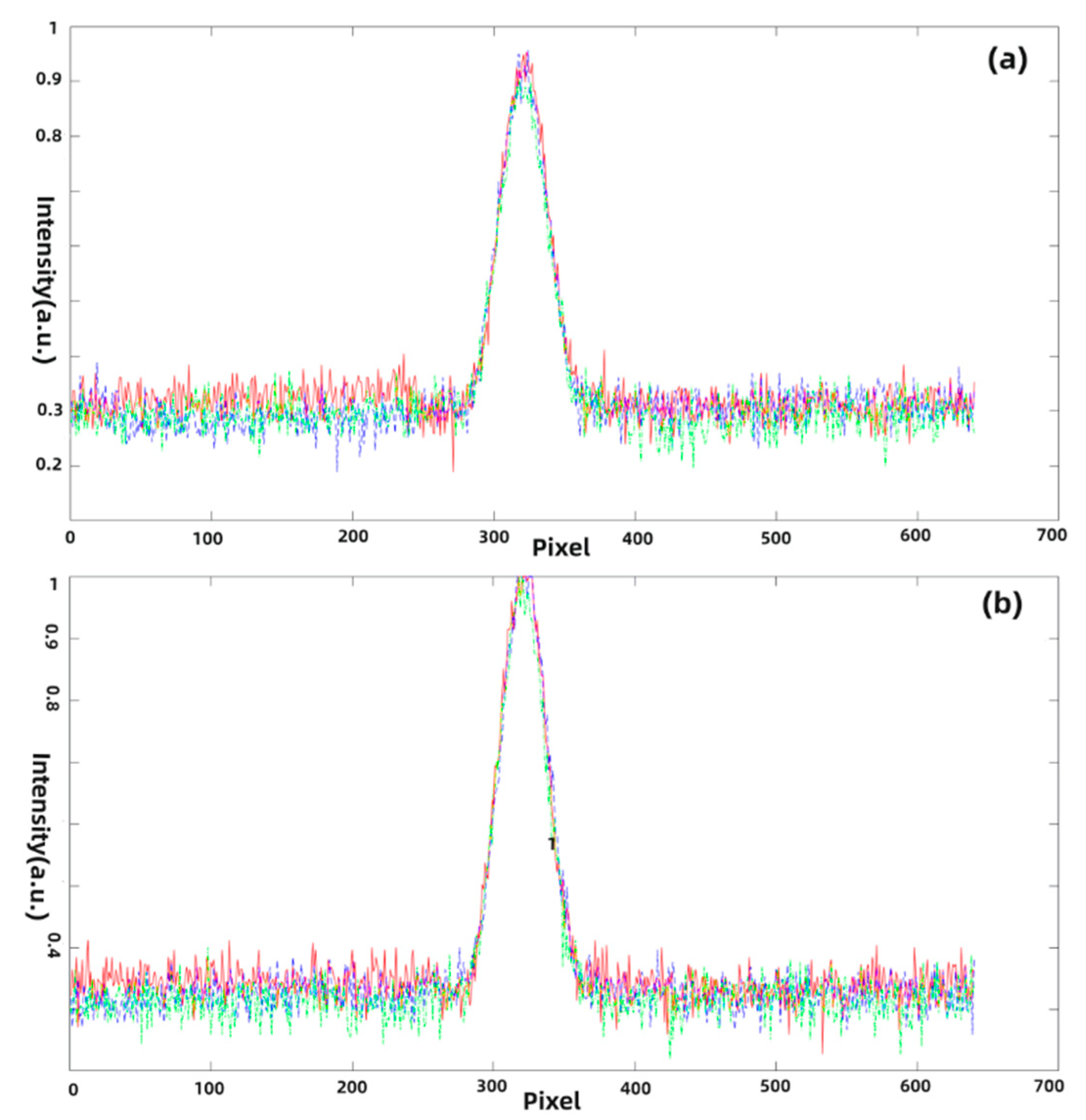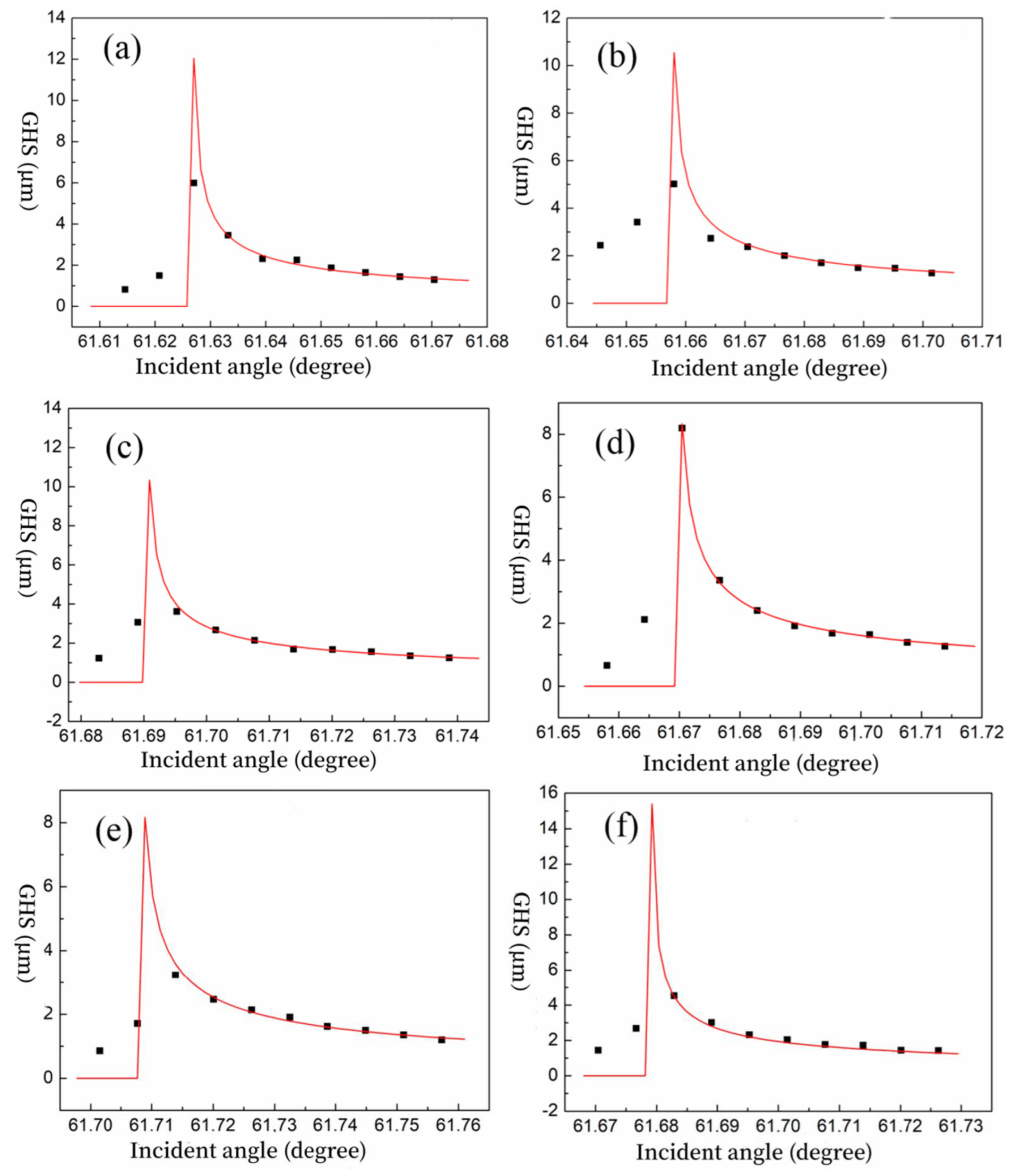Exploration of Illicit Drug Detection Based on Goos–Hänchen Shift
Abstract
:1. Introduction
2. Principles and Methods
2.1. Principle of Goos–Hänchen Shift
2.2. Experimental Device
2.3. Experimental Samples
3. Results and Discussion
4. Conclusions
Supplementary Materials
Author Contributions
Funding
Institutional Review Board Statement
Informed Consent Statement
Data Availability Statement
Conflicts of Interest
References
- Ju, L.; Lyu, A.; Hao, H.; Shen, W.; Cui, H. Deep Learning-Assisted Three-Dimensional Fluorescence Difference Spectroscopy for Identification and Semiquantification of Illicit Drugs in Biofluids. Anal. Chem. 2019, 91, 9343–9347. [Google Scholar] [CrossRef] [PubMed]
- Griffin, A.; Henry, J.; Kirkbride, K.P.; Painter, B.; Linacre, A. A survey of the effects of common illicit drugs on forensic DNA analysis. Forensic Sci. Int. 2022, 336, 111314. [Google Scholar] [CrossRef] [PubMed]
- Zulyadi, R. Obstacle Factors on Evidence System of Urine Test Result on Drugs Cases in National Narcotics Board of North Sumatera Province, Indonesia. Bp. Int. Res. Crit. Inst. (BIRCI-J.) Humanit. Soc. Sci. 2020, 3, 1316–1324. [Google Scholar] [CrossRef]
- Chen, W.; Li, X.; Huang, H.; Zhu, X.; Jiang, X.; Zhang, Y.; Cen, K.; Zhao, L.; Liu, X.; Qi, S. Comparison of gas chromatography-mass spectrometry and gas chromatography-tandem mass spectrometry with electron ionization for determination of N-nitrosamines in environmental water. Chemosphere 2017, 168, 1400–1410. [Google Scholar] [CrossRef] [PubMed]
- Deventer, K.; Pozo, O.J.; Van Eenoo, P.; Delbeke, F.T. Development of a qualitative liquid chromatography/tandem mass spectrometric method for the detection of narcotics in urine relevant to doping analysis. Rapid Commun. Mass Spectrom. 2007, 21, 3015–3023. [Google Scholar] [CrossRef]
- Fiorentin, T.R.; Logan, B.K.; Martin, D.M.; Browne, T.; Rieders, E.F. Assessment of a portable quadrupole-based gas chromatography mass spectrometry for seized drug analysis. Forensic Sci. Int. 2020, 313, 110342. [Google Scholar] [CrossRef]
- Saar-Reismaa, P.; Brilla, C.A.; Leiman, K.; Kaljurand, M.; Vaher, M.; Kulp, M.; Mazina-Šinkar, J. Use of a newly-developed portable capillary electrophoresis analyser to detect drugs of abuse in oral fluid: A case study. Talanta 2020, 211, 120662. [Google Scholar] [CrossRef]
- Trufelli, H.; Palma, P.; Famiglini, G.; Cappiello, A. An overview of matrix effects in liquid chromatography-mass spectrometry. Mass Spectrom. Rev. 2011, 30, 491–509. [Google Scholar] [CrossRef]
- Mosekiemang, T.T.; Stander, M.A.; de Villiers, A. Ultra-high pressure liquid chromatography coupled to travelling wave ion mobility-time of flight mass spectrometry for the screening of pharmaceutical metabolites in wastewater samples: Application to antiretrovirals. J. Chromatogr. A 2021, 1660, 462650. [Google Scholar] [CrossRef]
- Cîntǎ-Pînzaru, S.; Peica, N.; Küstner, B.; Schlücker, S.; Schmitt, M.; Frosch, T.; Faber, J.H.; Bringmann, G.; Popp, J. FT-Raman and NIR-SERS characterization of the antimalarial drugs chloroquine and mefloquine and their interaction with hematin. J. Raman Spectrosc. 2006, 37, 326–334. [Google Scholar] [CrossRef]
- Swerdlow, H.; Gesteland, R. Capillary gel electrophoresis for rapid, high resolution DNA sequencing. Nucleic Acids Res. 1990, 18, 1415–1419. [Google Scholar] [CrossRef] [PubMed]
- Xu, Y.; Gao, Y.; Wei, H.; Du, Y.; Wang, E. Field-amplified sample stacking capillary electrophoresis with electrochemiluminescence applied to the determination of illicit drugs on banknotes. J. Chromatogr. A 2006, 1115, 260–266. [Google Scholar] [CrossRef] [PubMed]
- Cialla, D.; März, A.; Böhme, R.; Theil, F.; Weber, K.; Schmitt, M.; Popp, J. Surface-enhanced Raman spectroscopy (SERS): Progress and trends. Anal. Bioanal. Chem. 2012, 403, 27–54. [Google Scholar] [CrossRef] [PubMed]
- Fan, R.; Liu, Z.; Jin, D.; Luo, T.; Li, N.; Li, S.; Wang, Y.; Xia, Y.; Lu, Z. High temporal waveform fidelity stimulated Brillouin scattering phase conjugate mirror using Novec-7500. Opt. Express 2023, 31, 1878–1887. [Google Scholar] [CrossRef] [PubMed]
- Dong, R.; Weng, S.; Yang, L.; Liu, J. Detection and direct readout of drugs in human urine using dynamic surface-enhanced Raman spectroscopy and support vector machines. Anal. Chem. 2015, 87, 2937–2944. [Google Scholar] [CrossRef] [PubMed]
- Weng, S.; Dong, R.; Zhu, Z.; Zhang, D.; Zhao, J.; Huang, L.; Liang, D. Dynamic surface-enhanced Raman spectroscopy and Chemometric methods for fast detection and intelligent identification of methamphetamine and 3, 4-Methylenedioxy methamphetamine in human urine. Spectrochim. Acta A Mol. Biomol. Spectrosc. 2018, 189, 1–7. [Google Scholar] [CrossRef]
- Fu, B.B.; Tian, X.D.; Song, J.J.; Wen, B.Y.; Zhang, Y.J.; Fang, P.P.; Li, J.F. Self-Calibration 3D Hybrid SERS Substrate and Its Application in Quantitative Analysis. Anal. Chem. 2022, 94, 9578–9585. [Google Scholar] [CrossRef]
- Goos, F.; Hänchen, H. Ein neuer und fundamentaler Versuch zur Totalreflexion. Ann. Phys. 1947, 436, 333–346. [Google Scholar] [CrossRef]
- Ullah, Z.; Ahmad, S.; Khan, T.; Jan, M.N.; Abdul Jabar, M.S. Complex conductivity dependent Goos–Hanchen shifts through metallic surface. J. Phys. B At. Mol. Opt. Phys. 2020, 53, 155401. [Google Scholar] [CrossRef]
- Jin, M.; Liu, J.; Xu, W.; Deng, D.; Han, L. Enhanced Goos-Hänchen Shift of SPR Sensor with TMDCs and Doped PANI/Chitosan Composites for Heavy Metal Ions Detection in Aquatic Environment. Plasmonics 2023, 18, 1129–1141. [Google Scholar] [CrossRef]
- Lang, Y.; Liu, Q.; Wang, Q.; Zhou, X.; Jia, G. Wavelength-dependent Goos-Hänchen shifts observed in one-dimensional photonic crystal films with different structures. Phys. Lett. A 2022, 449, 128348. [Google Scholar] [CrossRef]
- Olaya, C.M.; Hayazawa, N.; Hermosa, N.; Tanaka, T. Angular Goos-Hänchen Shift Sensor Using a Gold Film Enhanced by Surface Plasmon Resonance. J. Phys. Chem. A 2021, 125, 451–458. [Google Scholar] [CrossRef] [PubMed]
- Sun, D. A proposal for digital electro-optic switches with free-carrier dispersion effect and Goos-Hanchen shift in silicon-on-insulator waveguide corner mirror. J. Appl. Phys. 2013, 114, 4502. [Google Scholar] [CrossRef]
- Farmani, A.; Mir, A.; Sharifpour, Z. Broadly tunable and bidirectional terahertz graphene plasmonic switch based on enhanced Goos-Hänchen effect. Appl. Surf. Sci. 2018, 453, 358–364. [Google Scholar] [CrossRef]
- Tsakmakidis, K.L.; Boardman, A.D.; Hess, O. ‘Trapped rainbow’ storage of light in metamaterials. Nature 2007, 450, 397–401. [Google Scholar] [CrossRef]
- Liu, J.-Y.; Huang, T.-J.; Yin, L.-Z.; Han, F.-Y.; Liu, P.-K. High Sensitivity Terahertz Biosensor Based on Goos-Hnchen Effect in Graphene. IEEE Photonics J. 2020, 12, 1–6. [Google Scholar]
- Palermo, G.; Sreekanth, K.V.; Maccaferri, N.; Lio, G.E.; Nicoletta, G.; De Angelis, F.; Hinczewski, M.; Strangi, G. Hyperbolic dispersion metasurfaces for molecularbiosensing. Nanophotonics 2021, 10, 295–314. [Google Scholar] [CrossRef]
- Yuan, Y.; Peng, X.; Weng, X.; He, J.; Liao, C.; Wang, Y.; Liu, L.; Zeng, S.; Song, J.; Qu, J. Two-dimensional nanomaterials as enhanced surface plasmon resonance sensing platforms: Design perspectives and illustrative applications. Biosens. Bioelectron. 2023, 241, 115672. [Google Scholar] [CrossRef]
- Sang, W.; Huang, S.; Chen, J.; Dai, X.; Liu, H.; Zeng, Y.; Zhang, T.; Wang, X.; Qu, J.; Ho, H.P.; et al. Wavelength sequential selection technique for high-throughput multi-channel phase interrogation surface plasmon resonance imaging sensing. Talanta 2023, 258, 124405. [Google Scholar] [CrossRef]
- Zhang, C.; Hong, Y.; Li, Z.; Da, H. Giant and controllable Goos-Hnchen shift of monolayer graphene strips enabled by a multilayer dielectric grating structure. Appl. Opt. 2022, 61, 844–850. [Google Scholar] [CrossRef]
- Benam, E.R.; Sahrai, M.; Bonab, J.P. High sensitive label-free optical sensor based on Goos-Hänchen effect by the single chirped laser pulse. Sci. Rep. 2020, 10, 17176. [Google Scholar] [CrossRef] [PubMed]
- Ebert, M.; Weinbruch, S.; Hoffmann, P.; Ortner, H.M. The chemical composition and complex refractive index of rural and urban influenced aerosols determined by individual particle analysis. Atmos. Environ. 2004, 38, 6531–6545. [Google Scholar] [CrossRef]
- Chew, W.C.; Weedon, W.H. A 3D perfectly matched medium from modified maxwell’s equations with stretched coordinates. Microw. Opt. Technol. Lett. 1994, 7, 599–604. [Google Scholar] [CrossRef]
- Chuang, S.L. Lateral shift of an optical beam due to leaky surface-plasmon excitations. J. Opt. Soc. Am. A Opt. Image Sci. 1986, 3, 593–599. [Google Scholar] [CrossRef]
- Aminabhavi, T.M. Use of mixing rules in the analysis of data for binary liquid mixtures. J. Chem. Eng. Data 1984, 29, 54–55. [Google Scholar] [CrossRef]






| Sample | Water | Serum | Methamphetamine | Serum–Methamphetamine | Heroin | Serum–Heroin |
|---|---|---|---|---|---|---|
| Incident angle (degree) | 61.627 | 61.658 | 61.695 | 61.670 | 61.714 | 61.683 |
| GH displacement (μm) | 6.00 | 5.02 | 3.62 | 8.19 | 3.20 | 4.53 |
| Sample | Serum | Serum–Methamphetamine | Serum–Heroin |
|---|---|---|---|
| GHS/μm | 1.70 | 2.40 | 4.53 |
| Incident light power/μW | 95.3 | 95.3 | 95.3 |
| Reflected light power/μW | 71.3 | 70.1 | 64.8 |
| Transmitted light power/μW | 0.43 | 0.43 | 0.16 |
| Absorption coefficient/cm−1 | 5.90 | 5.97 | 7.70 |
| Extinction coefficient | 2.97 × 10−5 | 3.01 × 10−5 | 3.88 × 10−5 |
| Refractive index | 1.33333 | 1.33351 | 1.33362 |
Disclaimer/Publisher’s Note: The statements, opinions and data contained in all publications are solely those of the individual author(s) and contributor(s) and not of MDPI and/or the editor(s). MDPI and/or the editor(s) disclaim responsibility for any injury to people or property resulting from any ideas, methods, instructions or products referred to in the content. |
© 2023 by the authors. Licensee MDPI, Basel, Switzerland. This article is an open access article distributed under the terms and conditions of the Creative Commons Attribution (CC BY) license (https://creativecommons.org/licenses/by/4.0/).
Share and Cite
Wang, Y.; Zhou, X.; Fan, X.; Huang, X.; Zhang, L.; Wang, C. Exploration of Illicit Drug Detection Based on Goos–Hänchen Shift. Photonics 2023, 10, 1270. https://doi.org/10.3390/photonics10111270
Wang Y, Zhou X, Fan X, Huang X, Zhang L, Wang C. Exploration of Illicit Drug Detection Based on Goos–Hänchen Shift. Photonics. 2023; 10(11):1270. https://doi.org/10.3390/photonics10111270
Chicago/Turabian StyleWang, Yan, Xiaodi Zhou, Xinmin Fan, Xiaodong Huang, Lujun Zhang, and Chunyan Wang. 2023. "Exploration of Illicit Drug Detection Based on Goos–Hänchen Shift" Photonics 10, no. 11: 1270. https://doi.org/10.3390/photonics10111270
APA StyleWang, Y., Zhou, X., Fan, X., Huang, X., Zhang, L., & Wang, C. (2023). Exploration of Illicit Drug Detection Based on Goos–Hänchen Shift. Photonics, 10(11), 1270. https://doi.org/10.3390/photonics10111270




